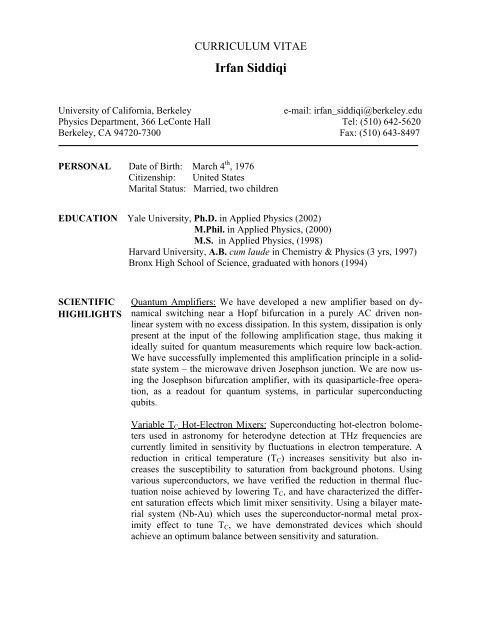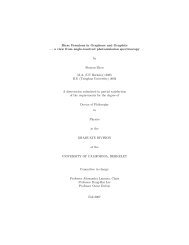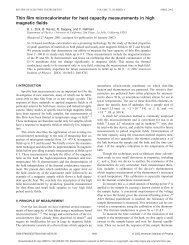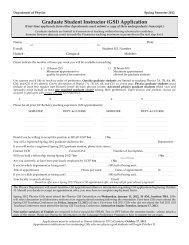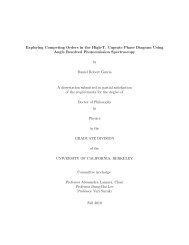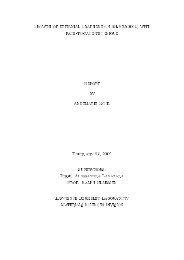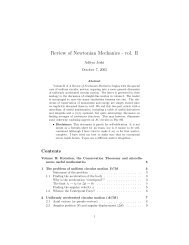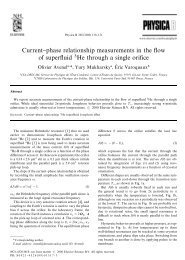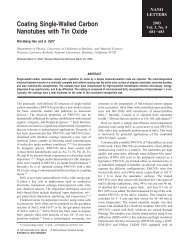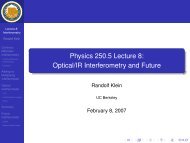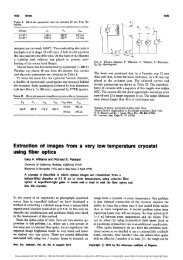Irfan Siddiqi - Physics - University of California, Berkeley
Irfan Siddiqi - Physics - University of California, Berkeley
Irfan Siddiqi - Physics - University of California, Berkeley
Create successful ePaper yourself
Turn your PDF publications into a flip-book with our unique Google optimized e-Paper software.
CURRICULUM VITAE<br />
<strong>Irfan</strong> <strong>Siddiqi</strong><br />
<strong>University</strong> <strong>of</strong> <strong>California</strong>, <strong>Berkeley</strong> e-mail: irfan_siddiqi@berkeley.edu<br />
<strong>Physics</strong> Department, 366 LeConte Hall Tel: (510) 642-5620<br />
<strong>Berkeley</strong>, CA 94720-7300 Fax: (510) 643-8497<br />
PERSONAL Date <strong>of</strong> Birth: March 4 th , 1976<br />
Citizenship: United States<br />
Marital Status: Married, two children<br />
EDUCATION Yale <strong>University</strong>, Ph.D. in Applied <strong>Physics</strong> (2002)<br />
M.Phil. in Applied <strong>Physics</strong>, (2000)<br />
M.S. in Applied <strong>Physics</strong>, (1998)<br />
Harvard <strong>University</strong>, A.B. cum laude in Chemistry & <strong>Physics</strong> (3 yrs, 1997)<br />
Bronx High School <strong>of</strong> Science, graduated with honors (1994)<br />
SCIENTIFIC Quantum Amplifiers: We have developed a new amplifier based on dy-<br />
HIGHLIGHTS<br />
namical switching near a Hopf bifurcation in a purely AC driven nonlinear<br />
system with no excess dissipation. In this system, dissipation is only<br />
present at the input <strong>of</strong> the following amplification stage, thus making it<br />
ideally suited for quantum measurements which require low back-action.<br />
We have successfully implemented this amplification principle in a solidstate<br />
system – the microwave driven Josephson junction. We are now using<br />
the Josephson bifurcation amplifier, with its quasiparticle-free operation,<br />
as a readout for quantum systems, in particular superconducting<br />
qubits.<br />
Variable TC Hot-Electron Mixers: Superconducting hot-electron bolometers<br />
used in astronomy for heterodyne detection at THz frequencies are<br />
currently limited in sensitivity by fluctuations in electron temperature. A<br />
reduction in critical temperature (TC) increases sensitivity but also increases<br />
the susceptibility to saturation from background photons. Using<br />
various superconductors, we have verified the reduction in thermal fluctuation<br />
noise achieved by lowering TC, and have characterized the different<br />
saturation effects which limit mixer sensitivity. Using a bilayer material<br />
system (Nb-Au) which uses the superconductor-normal metal proximity<br />
effect to tune TC, we have demonstrated devices which should<br />
achieve an optimum balance between sensitivity and saturation.
RESEARCH Assistant Pr<strong>of</strong>essor (on leave 2005) July 1, 2005-Present<br />
POSITIONS <strong>Physics</strong> Department, UC <strong>Berkeley</strong><br />
Postdoctoral Associate March 2002-June 2006<br />
Applied <strong>Physics</strong> Dept., Yale <strong>University</strong> New Haven, CT<br />
Research topic: Microwave measurements on mesoscopic systems with<br />
emphasis on superconducting charge-phase qubits and novel Josephson effect<br />
devices.<br />
Supervisor: Pr<strong>of</strong>. Michel Devoret<br />
Graduate Researcher September 1997-February<br />
2002 Applied <strong>Physics</strong> Dept., Yale <strong>University</strong> New Haven, CT<br />
Dissertation topic: “Critical Temperature Dependence <strong>of</strong> High Frequency<br />
Electron Dynamics in Superconducting Hot-Electron Bolometer Mixers.”<br />
Graduate Advisor: Pr<strong>of</strong>. Daniel Prober<br />
Research Assistant September 1995-June 1997<br />
<strong>Physics</strong> Dept., Harvard <strong>University</strong> Cambridge, MA<br />
Undergraduate thesis topic: “Absolute Quantum Efficiency Measurements<br />
<strong>of</strong> a Prototype Ultra-Cold Neutron in Liquid Helium Detection System.”<br />
Undergraduate Advisor: Pr<strong>of</strong>. John Doyle<br />
Research Intern Summer 1996<br />
HYPRES Inc. Elmsford, NY<br />
Advisors: Dr. Raymond Robertazzi & Dr. David Osterman<br />
Research Assistant Summer 1994&1995<br />
Astrophysics Dept., Columbia <strong>University</strong> New York, NY<br />
Advisor: Pr<strong>of</strong>. Joseph Patterson<br />
Research Intern Summer 1992-December 1993<br />
Materials Science Dept., Polytechnic <strong>University</strong> Brooklyn, NY<br />
Advisor: Pr<strong>of</strong>. Harold Margolin<br />
TEACHING Instructor Fall 2006<br />
EXPERIENCE <strong>Physics</strong> H7B<br />
UC <strong>Berkeley</strong> (Honors Electricity and Magnetism)<br />
Teaching Fellow level II Fall 1998, 1999, 2000& 2001<br />
Engineering & Applied Science 506a/<strong>Physics</strong> 439a<br />
Yale <strong>University</strong> (Basic Quantum Mechanics)<br />
Teaching Fellow level II Spring 1998&1999<br />
Engineering & Applied Science 110b<br />
Yale <strong>University</strong> (Perspectives on Technology)
Teaching Fellow level I Fall 1999<br />
Engineering & Applied Science 650a<br />
Yale <strong>University</strong> (Instrumentation & Product Design)<br />
OTHER Cleanroom Committee Chairman February 2000-August 2000<br />
EXPERIENCE Yale Center for Microelectronic Materials and Structures<br />
Committee Member 1998-Present<br />
Fellowships<br />
NASA Graduate Student Researchers Program, 1997-2000<br />
Edward Barlow Fellowship, Yale <strong>University</strong>, 1997-1998<br />
Q Entry Scholarship, Harvard <strong>University</strong>, 1997<br />
Harvard Scholarship for Academic Excellence, 1997<br />
New York Governor’s Award and Scholarship 1994-1996<br />
Honors<br />
The UC <strong>Berkeley</strong> Hellman Faculty Fund (2007)<br />
The Office <strong>of</strong> Naval Research, Young Investigator Award (2007)<br />
The George E. Valley Prize, American Physical Society (2006)<br />
The Harding Bliss Prize, Yale <strong>University</strong> (2002)<br />
The Harvard Foundation for Intercultural and Race Relations Citation (1997)<br />
Perkins Prize, Lowell House Harvard <strong>University</strong> (1997)<br />
New York Academy <strong>of</strong> Sciences: NYC School Technology Expo First Place (1994)<br />
New York State Science Talent Search Highest Honor, (1994)<br />
Rensselaer Polytechnic Institute Medal, Outstanding Achievement in Math and Sci. (1994)<br />
American Mathematics Competitions Certificate <strong>of</strong> Achievement (1994)<br />
National Honor Society (1994)<br />
Nat. Consortium for Specialized Schools <strong>of</strong> Math, Sci. and Tech. National Scholar (1994)<br />
Columbia Engineering Alumni Association Award (1994)<br />
Nynex Award (1994)<br />
Columbia <strong>University</strong> Science Honors Program (1993-1994)<br />
New York Mathematics Fair Gold Medal (1993)<br />
Who’s Who in American High School Students (1992-1994)<br />
New York Academy <strong>of</strong> Sciences: NYC School Technology Expo Second Place (1993)<br />
Lehigh <strong>University</strong> Materials Camp, Lehigh <strong>University</strong> (1992)<br />
New York Academy <strong>of</strong> Sciences: NYC School Technology Expo Second Place (1990)
1. “Entangled Solid-State Circuits”<br />
I. <strong>Siddiqi</strong> and J. Clarke<br />
Science 313, 1400 (2006).<br />
Refereed Journal Publications<br />
2. “Dispersive Measurements <strong>of</strong> Superconducting Qubit Coherence with a Fast, Latching<br />
Readout”<br />
I. <strong>Siddiqi</strong>, R. Vijay, M. Metcalfe, E. Boaknin, L. Frunzio, and M.H. Devoret<br />
Phys. Rev. B 73, 054510 (2006).<br />
3. “An RF-Driven Josephson Bifurcation Amplifier for Quantum Measurements”<br />
I. <strong>Siddiqi</strong>, R. Vijay, F. Pierre, C.M. Wilson, M. Metcalfe, C. Rigetti, L. Frunzio, and<br />
M.H. Devoret, Phys. Rev. Lett. 93, 207002 (2004).<br />
4. “Direct Observation <strong>of</strong> Dynamical Switching between Two Driven Oscillation States <strong>of</strong> a<br />
Josephson Junction.<br />
I. <strong>Siddiqi</strong>, R. Vijay, F. Pierre, C.M. Wilson, L. Frunzio, M. Metcalfe, C. Rigetti, R.J.<br />
Schoelkopf, and M.H. Devoret, Phys. Rev. Lett. 94, 027005 (2005).<br />
5. “Nb-Au Bilayer Hot-Electron Bolometers for Low-Noise THz Heterodyne Detection”<br />
I. <strong>Siddiqi</strong> and D.E. Prober, Appl. Phys. Lett. 84, 1404 (2004).<br />
6. “Primary Electronic Thermometry using the Shot Noise <strong>of</strong> a Tunnel Junction”<br />
L. Spietz, K. Lehnert, I. <strong>Siddiqi</strong>, and R.J. Schoelkopf, Science 300, 1929 (2003).<br />
7. “Heterodyne Mixing in Aluminum Superconducting Hot-Electron Bolometer Mixers”<br />
I. <strong>Siddiqi</strong>, A. Verevkin, R. Jahn, D.E. Prober, A. Skalare,W.R. McGrath, P.M. Echter<br />
nach and H.G. LeDuc, J. Appl. Phys. 91, 4646 (2002).<br />
8. “Noise and Conversion Efficiency in Aluminum Superconducting Hot Electron Bolome<br />
ter Mixers”<br />
I. <strong>Siddiqi</strong>, A. Verevkin, D.E. Prober, A. Skalare, W.R. McGrath, P.M. Echternach and<br />
H.G. LeDuc, IEEE Trans. Appl. Supercond. 11, 958 (2001).<br />
9. “Aluminum Hot-Electron Bolometer Mixers at Submillimeter Wavelengths”<br />
A. Skalare, W.R. McGrath, P.M. Echternach, H.G. LeDuc, I. <strong>Siddiqi</strong>, A Verevkin, and<br />
D.E. Prober, IEEE Trans. Appl. Supercond. 11, 641 (2001).<br />
10. “Flux Trapping Experiments in Single Flux Quantum Shift Registers”<br />
R. Robertazzi, I. <strong>Siddiqi</strong>, and O. Mukhanov, IEEE Trans. Appl. Supercond. 7, 3164<br />
(1997).
Published Conference Proceedings<br />
1. “The Josephson Bifurcation Amplifier for Quantum Measurements"<br />
I. <strong>Siddiqi</strong>, R. Vijay, F. Pierre, C.M. Wilson, L. Frunzio, M. Metcalfe, C. Rigetti, and<br />
M.H. Devoret<br />
In Quantum Computation in Solid State Systems, B. Ruggiero, P. Delsing, C. Granata, Y.<br />
Pashkin, and P. Silvertrini (eds.). Springer, Vol. XVI, 337 pp., ISBN 0-387-26332-2<br />
(2006).<br />
2. “Reduced-Tc Nb Superconducting Hot-Electron Bolometer Mixers”<br />
I. <strong>Siddiqi</strong>, D.E. Prober, B. Bumble, and H.G. LeDuc<br />
Proceedings <strong>of</strong> the 12 th International Symposium on Space Terahertz Technology, San<br />
Diego, CA, February 2001, pp. 36-41.<br />
3. “Aluminum Sub-Micron Superconducting Hot-Electron Bolometer Mixers”<br />
I. <strong>Siddiqi</strong>, A. Verevkin, D.E. Prober, A. Skalare, B.S. Karasik, W.R. McGrath, P.M.<br />
Echternach, and H.G. LeDuc<br />
Proceedings <strong>of</strong> the 11 th International Symposium on Space Terahertz Technology, Ann<br />
Arbor, MI, May 2000, pp. 82-94.<br />
4. “Diffusion-Cooled Aluminum Hot-Electron Bolometer Mixers at Submillimeter Wave<br />
lengths”<br />
A. Skalare, W.R. McGrath, P.M. Echternach, H.G. LeDuc, I. <strong>Siddiqi</strong>, A. Verevkin, and<br />
D.E. Prober<br />
Proceedings <strong>of</strong> the 11 th International Symposium on Space Terahertz Technology, Ann<br />
Arbor, MI, May 2000, pp. 501-512.<br />
Invited Talks<br />
“Amplifying Quantum Signals with the Josephson Bifurcation Amplifier (JBA)”<br />
IV International workshop on Macroscopic Quantum Coherence and Computing<br />
Palazzo Serra di Cassano, Via Monte di Dio 14, Napoli, Italy 7-10 June, 2004<br />
“Using a Dynamical Bifurcation to Readout a Quantum Bit”<br />
Gordon Research Conference on Quantum Information Science, February 2005.<br />
“Amplifying Quantum Signals with the Josephson Bifurcation Amplifier (JBA)”<br />
2005 March Meeting, Los Angeles CA.<br />
“Metastable State <strong>of</strong> the Josephson Junction”<br />
Boulder Summer School, July 2005.<br />
“Bifurcation Readout for Superconducting Qubits”<br />
Boulder Summer School, July 2005.
“Non-linear Dispersive Measurements <strong>of</strong> the Quantronium Qubit”<br />
GDEST EU-US Workshop on “Quantum Information and Coherence”<br />
Munich, 7 – 9 December 2005.<br />
“Non-linear Dispersive Measurements <strong>of</strong> the Quantronium Qubit”<br />
Gordon Research Conference on Superconductivity, January 2006.<br />
“Information Flow in the Readout <strong>of</strong> a Superconducting Qubit”<br />
Quantum Computing and Many Body Systems, February 2005.<br />
“Quantum Activation in the Josephson Bifurcation Amplifier”<br />
International Workshop on Nanoscale Superconductivity and Magnetism – MESO ’06,<br />
Chernogolovka, June 2006.<br />
“Quantronium: A Superconducting Wheatstone Bridge”<br />
Applied Superconductivity Conference, August 2006.<br />
Seminars/Colloquia<br />
“THE JOSEPHSON BIFURCATION AMPLIFIER: A new readout for superconducting<br />
qubits”<br />
-Michigan State <strong>University</strong>, Institute for Quantum Sciences Seminar, April 21, 2004.<br />
“BIFURCATION AMPLIFICATION IN AN RF-DRIVEN JOSEPHSON JUNCTION:<br />
A new readout for superconducting qubits”<br />
-NIST, Electronics and Electrical Engineering Laboratory, January 15, 2004.<br />
-Caltech, <strong>Physics</strong> Seminar, February 17, 2004.<br />
“AMPLIFYING QUANTUM SIGNALS WITH THE JOSEPHSON BIFURCATION<br />
AMPLIFIER”<br />
-City College, City <strong>University</strong> <strong>of</strong> New York, <strong>Physics</strong> Seminar, October 29, 2004.<br />
“COMMUNICATING WITH THE QUANTUM WORLD USING A CLASSIC DY-<br />
NAMICAL BIFURCATION”<br />
-<strong>University</strong> <strong>of</strong> Washington, Seattle, <strong>Physics</strong> Colloquium, December 6, 2004.<br />
“USING A DYNAMICAL BIFURCATION TO READOUT A QUANTUM BIT”<br />
- <strong>University</strong> <strong>of</strong> South Carolina, Nanocenter, <strong>Physics</strong> Colloquium, January 13, 2005.<br />
- Northeastern <strong>University</strong>, <strong>Physics</strong> Colloquium, January 18, 2005.<br />
- Massachusetts Institute <strong>of</strong> Technology, <strong>Physics</strong> Seminar, January 20, 2005.<br />
- Boston College, <strong>Physics</strong> Colloquium, February 2, 2004.<br />
- <strong>University</strong> <strong>of</strong> Chicago, James Franck Institute, February 15, 2005.<br />
- Harvard <strong>University</strong>, March 11, 2005.<br />
- Georgia Institute <strong>of</strong> Technology, February 21, 2005.<br />
- UC <strong>Berkeley</strong>, April 4, 2005.
“OBSERVATION OF THE DYNAMICAL CASIMIR EFFECT IN THE JOSEPHSON<br />
BIFURCATION AMPLIFIER”<br />
Quantronics Group, CEA, Saclay, June 2006.<br />
“USING A DYNAMICAL BIFURCATION TO READOUT A QUANTUM BIT”<br />
Louis Neel Laboratory, CNRS, Grenoble, June 2006.<br />
Conferences Presentations<br />
American Physical Society March Meeting, Baltimore, Maryland March 2006<br />
Applied Superconductivity Conference, Jacksonville, FL October 2004<br />
Macroscopic Quantum Coherence and Computing, Naples, Italy June 2004<br />
American Physical Society March Meeting, Montreal, Canada March 2004<br />
Army Research Office Program Review, Nashville, TN August 2003<br />
U.S.-Australia Workshop on Solid State and Optical Approaches January 2003<br />
to Quantum Information Science, Sydney, Australia<br />
Army Research Office Program Review, Nashville, TN August 2002<br />
Applied Superconductivity Conference, Houston, TX August 2002<br />
NATO-ASI “New Trends in Mesoscopic <strong>Physics</strong>”, Erice, Italy July 2002<br />
13 th Int’l Symposium on Space Terahertz Technology, Cambridge, MA March 2002<br />
American Physical Society March Meeting, Indianapolis, IN March 2002<br />
9 th Int’l Conference on Terahertz Electronics, Charlottesville, VA October 2001<br />
American Physical Society March Meeting, Seattle, WA March 2001<br />
12 th Int’l Symposium on Space Terahertz Technology, San Diego, CA February 2001<br />
Applied Superconductivity Conference, Virginia Beach, VA September 2000<br />
Space Astrophysics Detectors and Detector Technologies, Baltimore, MD June 2000<br />
11 th Int’l Symposium on Space Terahertz Technology, Ann Arbor, MI May 2000<br />
American Physical Society March Meeting, Minneapolis, MN March 2000<br />
Research Description<br />
Yale <strong>University</strong> Postdoctoral Research: We are currently developing novel amplifiers<br />
based on the transition between different driven oscillation states in the vicinity <strong>of</strong> a Hopf<br />
bifurcation in a Josephson junction. These oscillation states differ in their oscillation phase,<br />
and therefore can be readily detected using microwave reflection measurements. Precise<br />
characterization and control <strong>of</strong> the Josephson non-linearity is achieved by shunted the junction<br />
with a lithographic capacitor to tune the plasma oscillation frequency. In this amplification<br />
scheme, no on-chip resistors are needed and the only dissipative element is load impedance<br />
<strong>of</strong> the circuitry used to detect the bifurcation amplifier signal. There is therefore no loss<br />
<strong>of</strong> information to parasitic dissipation. Also the only back-action in this amplifier is due to<br />
phase fluctuations in the readout junction induced by thermal noise in the load at the output<br />
<strong>of</strong> the bifurcation amplifier, thus yielding an ultra-low input noise temperature. No quasiparticles<br />
are generated in the dynamical transition as the junction never switches into the voltage<br />
state, reducing quasiparticle poisoning and permitting fast operation. Such amplifiers, when
properly optimized, should have comparable sensitivity to SQUIDs but with minimal backaction<br />
and quasiparticle-free operation. We have fabricated and performed microwave tests<br />
on Josephson bifurcation amplifiers, and have shown that they perform in accordance with<br />
simple theoretical predictions. We are currently integrating these amplifiers with superconducting<br />
qubits to perform stringent tests <strong>of</strong> quantum mechanics such as the violation <strong>of</strong> Bell’s<br />
inequalities.<br />
Yale <strong>University</strong> Graduate Research (http://www.yale.edu/proberlab/): Ultra-sensitive,<br />
thin-film superconducting hot-electron bolometer (HEB) terahertz mixers are ideal for remote-sensing<br />
applications in radio-astronomy, upper atmospheric chemistry, and planetary<br />
science. The focus <strong>of</strong> my research was to improve the performance <strong>of</strong> HEB mixers by using<br />
superconductors with a lower critical temperature than Nb (TC=5-6K). I worked on both the<br />
e-beam fabrication and microwave (40 GHz) testing <strong>of</strong> these devices at subkelvin temperatures.<br />
In our experiments, we took two different approaches to produce lower TC mixers.<br />
First, by applying a magnetic field, the TC <strong>of</strong> Nb HEBs was varied in a continuous fashion.<br />
Second, we studied Al and Nb-Au (superconductor-normal metal bilayer) mixers which have<br />
Tc < 2K. We demonstrated that mixer sensitivity increases linearly by lowering TC due to a<br />
decrease in thermal fluctuation noise. We also characterized saturation at the input and output<br />
ports <strong>of</strong> the mixer due to incident broadband noise. In the course <strong>of</strong> these measurements, we<br />
observed novel phenomena in these superconducting nanobridges that arise from proximity<br />
effects that place size limitations, and therefore bandwidth limitations on nanostructure devices.<br />
The Nb-Au bilayer HEBs fabricated at Yale are planned for use in focal plane arrays<br />
on the Heinrich Hertz telescope and on AST/RO at the South Pole in collaboration with the<br />
<strong>University</strong> <strong>of</strong> Arizona. HEBs are also planned for use on the NASA/DLR Stratospheric Observatory<br />
for Infrared Astronomy (SOFIA) (http://s<strong>of</strong>ia.arc.nasa.gov/) and on the Herschel<br />
Far Infrared and Submillimeter Telescope (FIRST) (http://sci.esa.int/first/) satellite.<br />
Harvard <strong>University</strong> (http://www.doylegroup.harvard.edu/): The ultra-cold neutron (UCN)<br />
experiment is aimed at exploring fundamental neutron physics, such as the free neutron betadecay<br />
lifetime, by magnetically trapping UCNs in liquid helium and detecting the ultraviolet<br />
radiation emitted by the helium upon absorption <strong>of</strong> beta particles from the neutron decay.<br />
The ultraviolet emission is converted to the visible by way <strong>of</strong> scintillators such as tetraphenyl<br />
butadiene. My work focused on simulating the detection experiment by using the decay<br />
products <strong>of</strong> a 210 Po source in liquid helium to induce scintillations. Collaborators include<br />
NIST, HMI (Berlin), and Los Alamos National Lab.<br />
HYPRES (http://hypres.hypres.com/): I investigated various aspects <strong>of</strong> the fabrication and<br />
testing <strong>of</strong> digital rapid single flux quantum (RSFQ) superconducting circuits. In particular, I<br />
tested the effect <strong>of</strong> ground plane holes on flux trapping in SFQ shift registers. Also, new fabrication<br />
techniques for thermopile infrared detectors were developed.<br />
Columbia <strong>University</strong> (http://cba.phys.columbia.edu/jop/): My work here involved the study<br />
<strong>of</strong> light emission from cataclysmic variable stars. I used different mathematical techniques<br />
and wrote computer programs to analyze the quasi-periodic and flickering behavior <strong>of</strong> AL<br />
COM, V603 AQL, and other dwarf novae.
Polytechnic <strong>University</strong> (http://mechanical.poly.edu/): I conducted independent research<br />
aimed at improving the wetting and mechanical properties <strong>of</strong> 60/40 Sn-Pb solder. A new alloy<br />
consisting <strong>of</strong> Sn-Pb-Ti-Cu-Ni that had a ~20% increase in copper wettability and a<br />
~100% increase in shear strength was developed.<br />
References<br />
Pr<strong>of</strong>essor Michel H. Devoret (Postdoctoral Advisor)<br />
Department <strong>of</strong> Applied <strong>Physics</strong>, Yale <strong>University</strong><br />
PO Box 208284<br />
New Haven, CT 06520-8284<br />
Tel: 203-432-4277<br />
michel.devoret@yale.edu<br />
Pr<strong>of</strong>essor Daniel E. Prober (Graduate Advisor)<br />
Department <strong>of</strong> Applied <strong>Physics</strong> (Chairman), Yale <strong>University</strong><br />
PO Box 208284<br />
New Haven, CT 06520-8284<br />
Tel: 203-432-4280<br />
daniel.prober@yale.edu<br />
Pr<strong>of</strong>essor Robert Schoelkopf<br />
Department <strong>of</strong> Applied <strong>Physics</strong>, Yale <strong>University</strong><br />
PO Box 208284<br />
New Haven, CT 06520-8284<br />
Tel: 203-432-4289<br />
robert.schoelkopf@yale.edu<br />
Pr<strong>of</strong>essor Emeritus Werner P. Wolf (Teaching)<br />
Department <strong>of</strong> Applied <strong>Physics</strong>, Yale <strong>University</strong><br />
PO Box 208284<br />
New Haven, CT 06520-8284<br />
Tel: 203-432-2210<br />
werner.wolf@yale.edu<br />
Dr. Daniel Esteve<br />
Director <strong>of</strong> Research, Quantronics group<br />
SPEC-CEA Saclay<br />
91191 Gif-sur-Yvette FRANCE<br />
Tel: (33)+(0)169085529<br />
(33)+(0)169087341<br />
Fax: (33)+(0)169087442<br />
esteve@drecam.saclay.cea.fr
Dr. Elie K. Track<br />
Visiting Pr<strong>of</strong>essor<br />
Department <strong>of</strong> <strong>Physics</strong>, Fairfield <strong>University</strong><br />
1073 North Benson Road<br />
Fairfield, CT 06824<br />
Tel: (203) 254-4000 Ext. 2192<br />
etrack@mail.fairfield.edu<br />
Dr. John Martinis<br />
National Institute <strong>of</strong> Standards and Technology (NIST)<br />
Electromagnetic Technology Division<br />
325 Broadway, MC 814.00<br />
Boulder, Colorado 80305-3328<br />
Tel: 303-497-3597<br />
john.martinis@nist.gov


